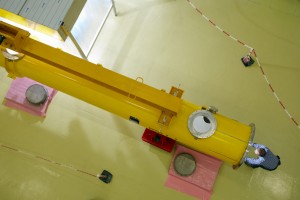
How will technological advances change the design of the cryomodule? We don’t know yet, but we know we have to keep looking, says Mike Harrison. Image: DESY
Mastery of difficult technologies is in the DNA of high-energy physics and the accelerators that enable the science. For many decades ever increasing beam energies and intensities have given rise to not just spectacular science results but also to a well documented stream of technical innovations which have resulted in spin-offs in many non-related fields. One of the most prominent –except maybe the web – has been the superconductor development for high-field accelerator magnets and its subsequent use in modern medical imaging. The ILC follows this tradition, and superconducting radiofrequency (SRF) technology, the basis for the main linac, can be found in most modern accelerators, be they light sources, free-electron lasers, high-intensity linacs or high-energy colliders. High technology, though, generally implies risk, and while the necessity for the technology is evident, what is less obvious is how to make the use of it optimal. An example of this is the choice of the accelerating gradient in the SRF cavities: if the design gradient is too low, the linac is longer than necessary and the costs increase; if the design gradient is too high, either the centre-of-mass energy ends up lower than required or many cavities fail to meet performance specifications, resulting in excessive costs and time delays.
In a very large project such as the ILC, there is a great deal of leverage in getting these basic decisions correct. The time-honoured method of establishing the technology is via an R&D programme. R&D was a major part of the Global Design Effort (GDE) programme over the past five years. For most projects at the end of the R&D phase, the technical design is frozen and the project moves into a construction phase. While this approach works in principle, it’s not quite that straightforward for the ILC. In a large international project in its initial stages the overall schedule is quite often not accurately known, and thus the boundary between R&D and construction can be uncertain. The ILC is in such a position today. Technological evolution of the cryomodule and cavity gradient processing continues in several laboratories, and we wish to derive the maximum benefit from these activities. We need to be certain however that any changes we choose to make do not introduce problems which are only revealed at a later stage. One of the (successful) goals of the GDE R&D programme was to identify and mitigate technical risks. If we choose to freeze the design of the major cost driving elements of the Technical Design Report baseline design, we will minimise project risk but miss out on any technical improvements made in the next several years. Introducing technical changes however obviously increases the risk of unforeseen difficulties at a later date. An example of the relentlessly dynamic nature of technology is the observation that today a single Google search request uses more processing power than the entire Apollo moon programme. While nobody is suggesting placing server farms into lunar orbit, it does illustrate why delaying technology decisions can sometimes be beneficial.
A major cost driver for the ILC is the cryomodule, and cryomodule design changes will be considered in the foreseeable future. Since the current design has been shown to meet the technical specifications we will proceed carefully in adopting any new features. Our ability to contemplate such an evolution is greatly helped by the concept of plug compatibility. This feature was incorporated into the cryomodule design at an early stage in the GDE programme. It allows individual cryomodule components to be replaced by other “plug-compatible” ones without requiring changes to other parts of the design. This provides a straightforward set of ground rules on how to make design changes which minimise the impact on other components and thus technical risk. With the European X-Ray Free-Electron Laser (XFEL) cryomodule construction now fully underway, it seems likely that during the next several years there will be some lessons learned that would be beneficial for the ILC programme. Maintaining the technical flexibility to obtain the maximum benefit from these activities is both a challenge and a necessity.


Recent Comments